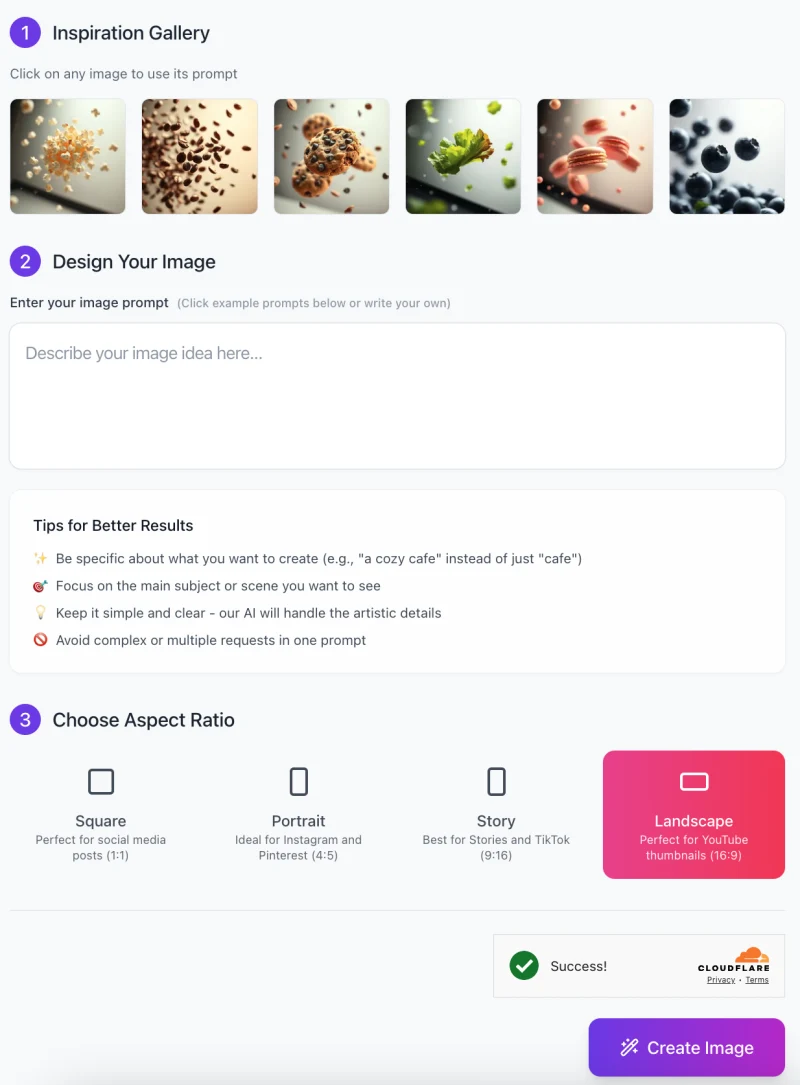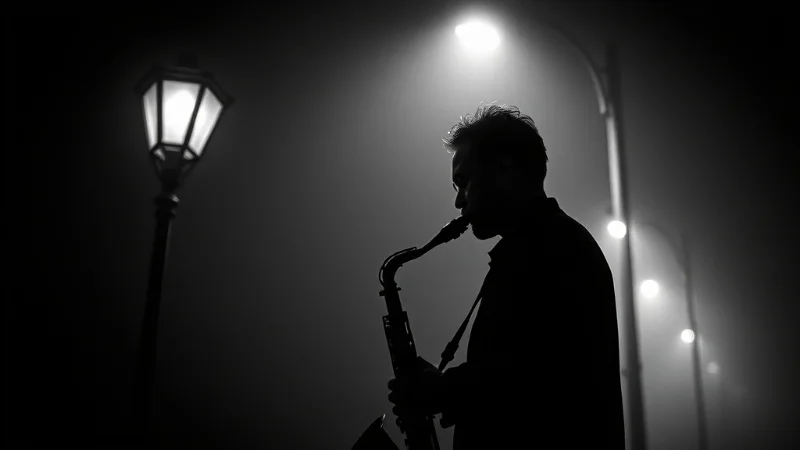Free AI Image Generator. No Sign-Up Required. Full Access.
AI HyperMotion Food Image Generator
AI HyperMotion Food Image Generator to generating high-speed, hyperrealistic flying food images, ideal for dynamic advertising, branding, and food photography.
Welcome to the AIFreeBox Free AI HyperMotion Food Image Generator online tool!
This tool allows you to effortlessly create stunning, high-speed food motion images with AI. Whether you need floating blueberries with water splashes, cookies breaking apart mid-air, or coffee beans tumbling dynamically, this generator brings your ideas to life with hyperrealistic details and cinematic motion effects.
Here, you’ll find everything you need to know to use the tool effectively, including features, tips, and best practices. Whether you’re a food blogger, marketer, advertiser, or creative professional, this guide will help you create eye-catching visuals that stand out and capture attention. Get ready to bring motion, energy, and realism to your food photography with just a few clicks!
What is AI HyperMotion Food Image Generator?
AI HyperMotion Food Image Generator lets you instantly create dynamic, floating food visuals without the need for expensive camera gear or professional photographers. With just a few clicks, you can generate stunning mid-air food shots that look professionally captured.
This tool uses advanced AI to simulate weightless, high-speed motion, making food appear floating, breaking apart, splashing, or tumbling in mid-air. It captures tiny details like crumbs, splashes, and flying particles, adding a sense of realism and depth.
Perfect for Advertising, Branding & Social Media
Motion-based food imagery grabs attention and makes food look exciting, fresh, and irresistible. Brands and creators use these visuals for social media marketing, website content, product packaging, and digital ads to stand out and create a sense of energy.Whether you’re a content creator, marketer, advertiser, or food business owner, this tool helps you generate eye-catching visuals that leave a lasting impact and make your content more engaging.
What Kind of Images Can You Create?
The AI HyperMotion Food Image Generator creates floating, weightless, and dynamic food visuals that look like high-speed photography shots. These images feature sharp details, dramatic lighting, and soft-focus backgrounds (bokeh), making them perfect for advertisements, social media, and creative projects.
Types of Images You Can Generate
✅ Fresh Ingredients in Motion
Blueberries splashing through water
Coffee beans tumbling mid-air with dust particles
Crisp lettuce leaves swirling dynamically
✅ Baked Goods with Elegant Motion Effects
Cookies breaking apart with crumbs flying
Macarons floating with delicate fragments
Croissants suspended in mid-air
✅ Beverages & Splash Effects
Coffee splashing in a cup
Juice pouring with frozen droplets mid-air
Cocktails swirling dynamically with light reflections
✅ Snacks & Sweets in Action
Popcorn exploding in mid-air
Chocolate pieces breaking apart
Colorful candies scattering dynamically
What Makes These Images Stand Out?
✔ Realistic lighting & depth of field for a cinematic look
✔ Dynamic motion effects like splashes, crumbs, and powder bursts
✔ Perfect for marketing, branding, and social media visuals
With this tool, your food photography will feel more engaging, professional, and full of life!
How to Use AI HyperMotion Food Image Generator: Step-by-Step Guide

Creating stunning high-speed food motion images is quick and easy with the AI HyperMotion Food Image Generator. Follow these simple steps to generate hyperrealistic, dynamic food visuals effortlessly.
Step 1: Get Inspired with the Inspiration Gallery
Before entering your own prompt, you can browse the Inspiration Gallery at the top of the interface.
- Click on any example image to use its prompt as a base.
- This is helpful if you’re unsure how to describe your desired image.
- You can tweak the selected prompt later to better match your vision.
Step 2: Enter Your Image Prompt
In the text box labeled “Describe your image idea here…”, enter a short and clear description of the image you want to generate.
Tips for writing a great prompt:
✅ Be specific (e.g., instead of “berries,” try “floating blueberries splashing in water”).
✅ Focus on the main subject (e.g., “chocolate chip cookies breaking apart in mid-air”).
✅ Keep it simple and clear – the AI will handle artistic details.
❌ Avoid complex or multiple requests in one prompt (e.g., “popcorn and coffee beans floating together with splashes” may lead to confusion).
Step 3: Choose Your Aspect Ratio

Select the aspect ratio that best fits your needs:
- Square (1:1) – Best for social media posts.
- Portrait (4:5) – Ideal for Instagram and Pinterest.
- Story (9:16) – Best for Stories and TikTok.
- Landscape (16:9) – Perfect for YouTube thumbnails and widescreen formats.
Click on your preferred aspect ratio to highlight it before proceeding.
Step 4: Generate Your Image
Once you’ve entered your prompt and chosen the aspect ratio:
- Click the “Create Image” button (purple button at the bottom).
- Wait a few seconds while the AI processes your request.
Step 5: Download and Use Your Image
- If you like the result, download the image to use in your projects.
- If you want a different variation, tweak your prompt and generate again.
- Experiment with different motion effects, lighting, and food items to get the best results.
By following these steps, you can effortlessly create eye-catching, high-speed food photography visuals for marketing, social media, or creative projects.
Pro Tips for Best Results
To create the most eye-catching, high-quality food motion images, follow these simple tips. These tricks will help you get sharper details, better lighting, and more realistic movement in your images.
1. Use Clear and Vivid Descriptions
The AI works best when you describe your image clearly and concisely. Instead of using general words like “fruit” or “cookies,” be specific:
✅ Say “juicy blueberries splashing in crystal-clear water” instead of just “blueberries.”
✅ Try “chocolate chip cookies breaking apart with crumbs flying” instead of just “cookies.”
More details help the AI create a sharper and more realistic image.
2. Add Dynamic Elements for More Impact
Motion effects make images look more exciting and professional. Try adding:
✔ Water splashes for fresh ingredients like fruits or vegetables.
✔ Crumbs and flakes for baked goods like cookies or croissants.
✔ Powder bursts or coffee dust for drinks and coffee beans.
These small details make the image feel alive and full of movement.
3. Use Contrasting Backgrounds
A good background makes the subject stand out. For example:
✔ Use a dark background for bright or white foods (e.g., popcorn, sugar, milk splashes).
✔ Use a light background for dark foods (e.g., coffee beans, chocolate pieces).
✔ Try soft gradient backgrounds to give a clean, modern look.
Avoid backgrounds that are too busy, as they can make the image feel cluttered.
4. Experiment with Lighting for a Cinematic Look
Lighting affects the mood and style of your image. Try different types of lighting:
✔ Soft lighting for a natural, airy feel (great for fresh foods).
✔ Dramatic lighting for deep shadows and a high-end look (great for coffee, chocolate).
✔ Backlighting to create glowing edges and highlight textures.
Playing with lighting helps you create stunning, professional-looking food visuals.
By following these tips, you’ll get sharper, more dynamic, and visually striking food motion images that stand out.
Common Issues & How to Fix Them
Sometimes, your generated image may not look as dynamic or realistic as you expect. Here are some common issues and simple fixes to improve your results.
1. Image Lacks Motion Effect
If the image looks too still and doesn’t have a sense of movement, try adding motion-related words to your prompt.
✅ Instead of “floating cookies,” try “chocolate chip cookies breaking apart with crumbs scattering.”
✅ Instead of “blueberries,” say “high-speed splash of fresh blueberries in water.”
Adding “splash,” “scatter,” or “burst” helps create a more exciting, dynamic effect.
2. The Subject Looks Too Static
If your food looks like it’s just sitting there instead of floating in motion, try using words that suggest weightlessness.
✅ Use “mid-air,” “floating,” “suspended in motion,” or “weightless” to make the subject look more natural.
✅ Instead of “coffee beans,” try “coffee beans tumbling mid-air with dust particles swirling.”
This makes the image feel alive and full of movement.
3. Background is Too Plain or Dull
A plain background can make the image look flat and boring. Add some variety with gradients, soft bokeh, or lighting effects.
✅ Instead of “floating macarons,” try “floating macarons with soft pastel gradient background.”
✅ Use “moody lighting” or “soft cinematic glow” to add depth.
This helps make your subject stand out and look more professional.
4. Elements Look Unnatural
If the food or motion effect looks fake or too artificial, adjust your description for better realism.
✅ Instead of “popcorn floating,” try “hyperrealistic popcorn exploding mid-air with tiny pieces flying around.”
✅ Add “cinematic lighting,” “realistic texture,” or “natural depth” to refine the effect.
These small tweaks make the final image look more polished and realistic.
By following these quick fixes, you can create stunning, high-speed food visuals that look natural, dynamic, and visually striking.
FAQs
1. What types of food images can I create?
You can generate high-speed, hyperrealistic images of food items floating in motion. Examples include:
✅ Fresh ingredients (fruits, vegetables, coffee beans, herbs)
✅ Baked goods (cookies, macarons, croissants)
✅ Beverages & splashes (coffee, juice, cocktails)
✅ Snacks & sweets (popcorn, chocolates, candies)
The AI captures motion effects like splashes, crumbs, and powder bursts for a dynamic look.
2. How do I write a good prompt for the best results?
Be specific and descriptive while keeping the prompt simple.
✅ Instead of “floating fruit”, try “high-speed splash of fresh blueberries in water”.
✅ Instead of “cookies”, use “chocolate chip cookies breaking apart with crumbs scattering.”
Adding words like “floating,” “mid-air,” “weightless,” or “hyperrealistic” improves accuracy.
3. Can I control the background of my image?
Yes! You can customize the background by adding details in your prompt.
✔ Use “soft gradient background” for a clean, modern look.
✔ Try “moody lighting” for dramatic depth.
✔ Avoid cluttered backgrounds for better focus on the food.
4. Why does my image look too static?
If the image lacks movement, try adding motion-based words.
✔ Use “mid-air,” “floating,” “tumbling,” “bursting” to enhance movement.
✔ Include “high-speed effect,” “splashes,” or “scattered crumbs” for realism.
5. How long does it take to generate an image?
The AI processes your request in a few seconds. If it takes longer, try refreshing or simplifying your prompt.
6. Can I use the generated images for commercial purposes?
Yes! You can use the images for marketing, branding, social media, websites, and ads. However, always review the AI’s output to ensure it fits your brand’s needs.
7. What should I do if my image doesn’t look right?
If the image doesn’t meet your expectations:
✔ Refine your prompt (be specific and add motion-related details).
✔ Adjust the background (try adding lighting effects or soft bokeh).
✔ Experiment with different wording (e.g., “realistic coffee beans tumbling with dust particles”).
8. Is there a limit to how many images I can create?
This tool offers unlimited use, so you can generate as many images as you want.










